Modular Laboratory Automation Market Size
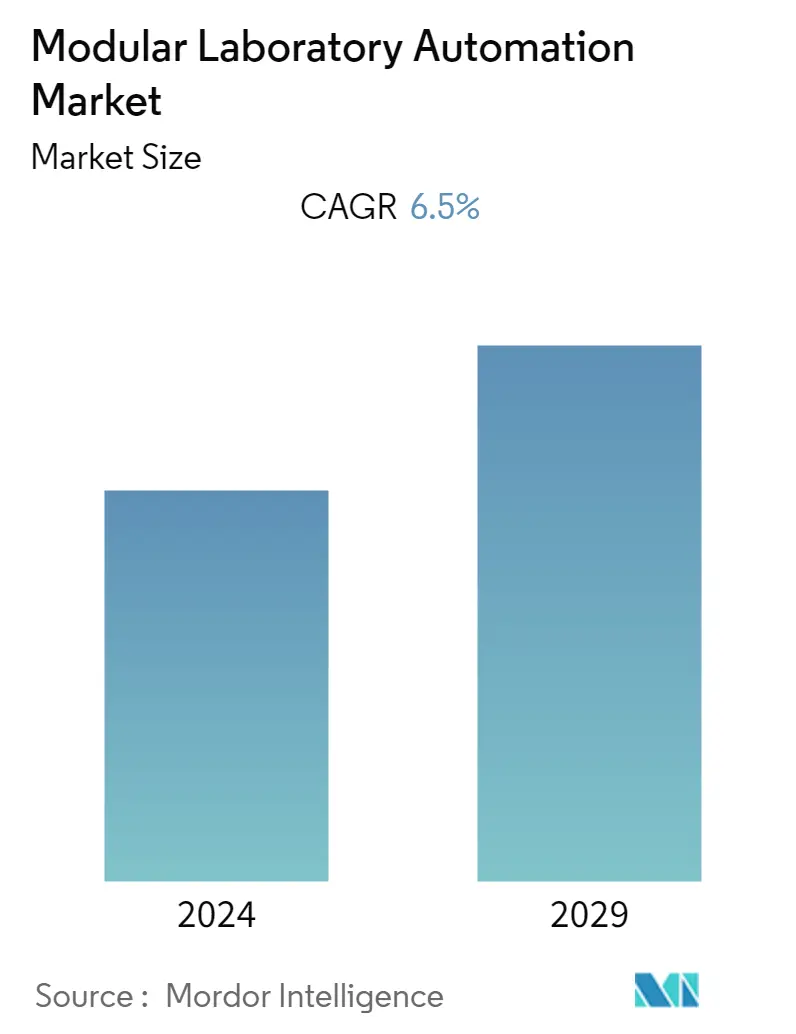
| Study Period | 2019 - 2029 |
| Base Year For Estimation | 2023 |
| CAGR | 6.50 % |
| Fastest Growing Market | Asia Pacific |
| Largest Market | North America |
| Market Concentration | Low |
Major Players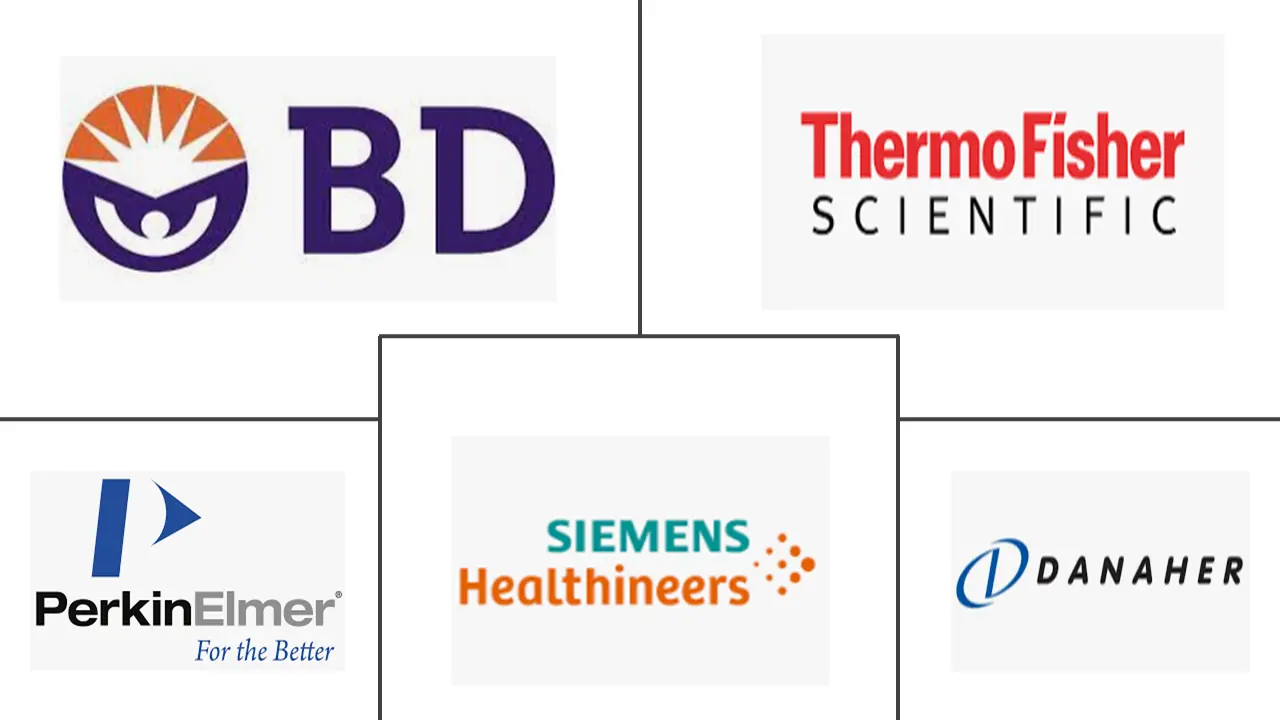
*Disclaimer: Major Players sorted in no particular order |
Modular Laboratory Automation Market Analysis
The modular laboratory automation market is anticipated to grow at a CAGR of 6.5% over the forecast period. Laboratory automation has transformed the medical laboratory space by steadily replacing semi-automatic and manual methods with fully automated systems. These automation systems are beneficial in sterile environments, wherein human error is significantly reduced and time is saved. Routine laboratory processes, such as testing, screening, etc., are automated. Automation tools can process concurrent requests in real time, showing marked improvement in productivity and throughput.
- One of the primary reasons expected to promote market expansion shortly is the rise in benefits given by lab automation. A paradigm change from total manual intervention to lab automation has various advantages for clinical laboratories. Reliable outcomes, safe working conditions, higher productivity, and significant time, space, and cost savings are just a few of the primary benefits. Lab automation makes it easier to utilize laboratory equipment for repetitive processes like sample verification and tube labeling and lowering and limiting the physical strain caused by manual chores, which saves money and space in the lab.
- Emerging markets are likely to provide considerable growth possibilities for lab automation product manufacturers and distributors during the projected period. Increasing demand for clinical diagnostic processes, resulting in increasing lab automation equipment sales. Major product manufacturers are expanding their distribution networks and production capabilities in new areas to increase their market share. This presents a profitable potential for laboratory automation.
- Liquid handlers and robotic arms are gradually becoming handy for performing different tasks with increased efficiency in modular laboratory environments. Conversely, the automation tools also handle the demand for the systematic execution of specific tasks, like running ELISA assays.
- In recent years, molecular diagnostic assays have relied significantly on real-time PCR technology, which detects the amplification of DNA in real-time, while PCR is in progress using a fluorescent reporter. More than 75% of clinic molecular diagnostic tests are amenable to real-time PCR procedures. This technology has provoked a new molecular biology market by offering rapid assays for better diagnosis and personalized treatment of complex diseases.
- Further, the use of laboratory automation tools in early cancer detection and increased adoption in microbiology have been the major contributors to the market growth in North America and Europe. MLA (Medical Laboratory Assistants) tools are widely employed for diagnosis in emerging markets like India and China, and the demand for these tools is expected to rise steadily.
- The COVID-19 pandemic has accelerated medicine development and research while putting additional strain on clinical laboratories and pharmaceutical companies. As a consequence of the increased interest in microplate readers, automated liquid handling, and robots, ensuring a shorter TAT has become a priority. On the other hand, the epidemic has resulted in lower revenues and margins for hospitals and health systems, as well as lower expenditures on automation and technology. As a result, the long-term market for modular laboratory automation is impacted.
Modular Laboratory Automation Market Trends
This section covers the major market trends shaping the Modular Laboratory Automation Market according to our research experts:
Automated Liquid Handlers Account for the Largest Market Share
- Liquid handlers are usually employed in biochemical and chemical laboratories. Automated liquid handling robots help in dispensing samples and other liquids in laboratories. Automated liquid handlers minimize run times and maximize accuracy. Moreover, liquid handlers are capable of operating across a wide range of volumes, extending into nanolitres, thus proving their usefulness in dispensing operations.
- Leading companies have set the benchmark for the development of automated liquid handlers and are constantly investing in developing premium products to increase productivity effectively. The evolution of the liquid handlers, capable of handling minute volumes of liquids, has contributed to the rapid development of modular lab automation systems in the market.
- According to the Robotic Industries Association, the life science sector has the third-highest growth in industrial robots, in terms of automated liquid handlers, automated plate handlers, robotic arms, and others, to meet the demand.
- According to Parker, one of the trends in life science robotics is fluidics getting simpler in robotic analyzers. This trend arose because clinical laboratories and hospitals cannot afford an instrument to go down when critical samples are involved. Certain robotic systems that used to have 50 needles on the end of a dispensing unit and lots of tubing increasingly use special valve manifolds that eliminate the need for tubing and result in less chance for failure. The manifolds basically minimize the chance of leakage.
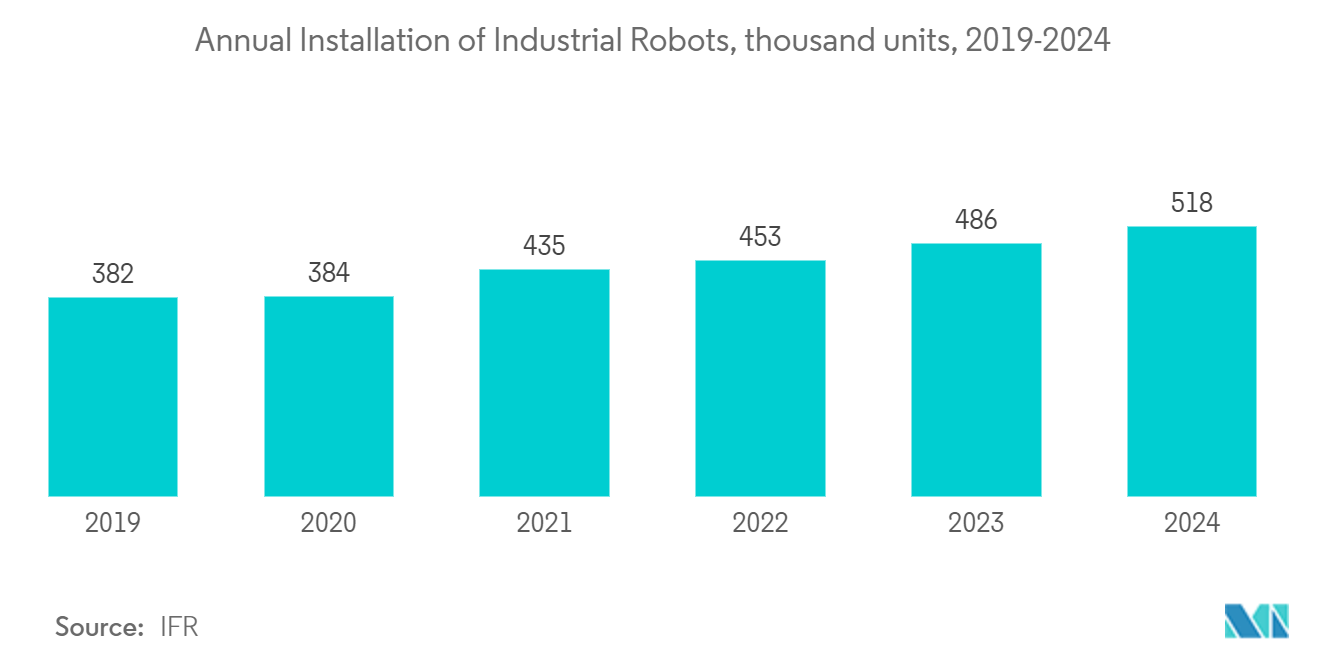
Asia Pacific to Witness Significant Growth Rate
- The Asia-Pacific region is anticipated to witness increased demand for lab automation solutions, primarily owing to the rapid growth in the pharmaceuticals market in this region. The growth can be attributed to the increased investment in pharmaceutical research and development in Asia-Pacific.
- In the Asia-Pacific region, the prolongation of economic and demographic trends, further healthcare reforms, and the policies articulated in the government's five-year plan are expected to propel the growth of the market. The high-growth market opens new opportunities for the vendors of lab automation solutions to expand their footprint.
- For instance, China, from the pharmaceuticals industry to medical products to consumer health, remains one of the world's most attractive markets and by far the fastest-growing of all the large emerging markets. Though there has been some decline in recent times, it remains a significant market for modular lab automation in the Asia-Pacific region.
- Furthermore, the region is ideal for conducting pharmaceutical research owing to the presence of a large pool of heterogeneous population groups, unlike other continents. This region is preferred the most to outsource pharmaceutical research, owing to the availability of skilled labor and lower cost required in the development of drugs.
- Many organizations are adopting modular laboratories, offering low-cost and reliable solutions. Modular laboratory automation is experiencing a growing demand in the market. South Korea is expected to become one of the technologically advanced nations. The increasing adoption of automation and innovations in technology by local companies is expected to boost the growth of the industry.
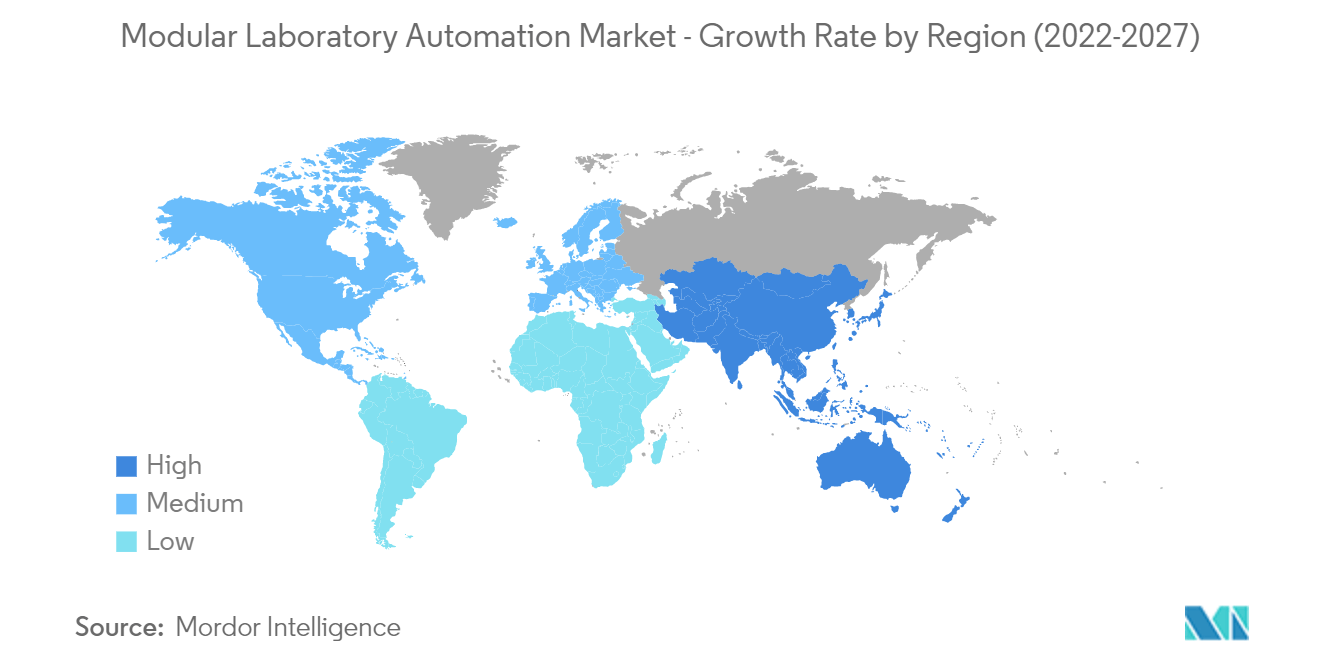
Modular Laboratory Automation Industry Overview
The modular laboratory automation market is fragmented. The rapid growth in the number of clinical and pre-clinical studies across the world has created a faster imperative in sample analysis. It reduces both machine downtime and manpower. With growing demand, companies are entering the market, making it attractive as well as competitive. Some of the key players in the market are Thermo Fisher Scientific, Danaher Corporation, Becton Dickinson, Siemens Healthcare, Synchron Lab Automation, Honeywell International Inc., Perkinelmer Inc., among others.
- March 2021 - PerkinElmer launched entire workflow solutions for the detection and screening of SARS-CoV-2 RNA, including instruments, reagents, and consumables. The modular automated workstations, combined with a reliable supply of corporate consumables and reagents, can optimize the productivity of SARS-CoV-2 testing by processing up to 10,000 samples per day.
- March 2021 - Thermo Fisher Scientific announced a strategic technology collaboration to develop a comprehensive and integrated software automation platform for Thermo Fisher's standardized COVID-19 Testing Platform. Increased testing throughput and assistance for global healthcare efforts will emerge from the integration.
- March 2021 - Becton, Dickinson, and Company, a pioneer in medical technology, has announced the launch of a Urine Culture Application in conjunction with the BD Kiestra lab automation incubation as well as an imaging system in the United States, which has the potential to revolutionize the way microbiology labs approach urine culture analysis.
Modular Laboratory Automation Market Leaders
-
Thermo Fisher Scientific
-
Danaher Corporation
-
Becton Dickinson
-
Siemens Healthcare
-
PerkinElmer
*Disclaimer: Major Players sorted in no particular order
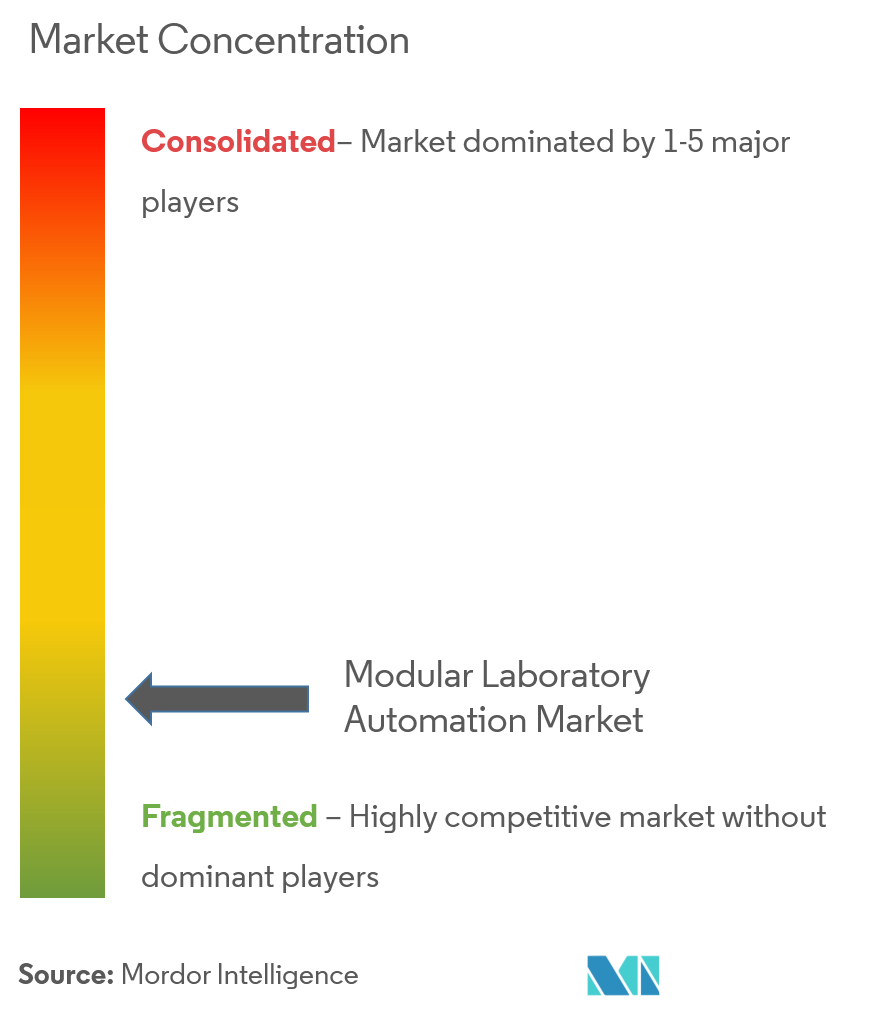
Modular Laboratory Automation Market News
- June 2022 - MegaRobo Technologies Ltd announced the completion of a USD 300 million Series C fundraising round. MegaRobo would use the funds to continue its R&D investments, capacity growth, and global expansion. MegaRobo has offered the life sciences industry a comprehensive set of automation solutions. Ranging from benchtop workflow automation for simple workflows to a fully automated platform for complex workflows in large system journey applications, with plans to expand into the next-generation life sciences infrastructure system for R&D and AI drug development.
- May 2022 - Global life science innovators MGI Tech Co. Ltd (MGI) and King Abdullah International Medical Research Center (KAIMRC) signed a Memorandum of Understanding (MOU) to form a strategic collaboration in the domains of genomic science and biotechnology. The MOU anticipates establishing a high-throughput sequencing center in KAIMRC, which may accommodate MGI's technology platforms, including DNBSEQ sequencing, laboratory automation, and bioinformatics products. Driven by MGI's proprietary DNBSEQ technology, the partnership will employ MGI's platform to improve genome sequencing and data quality across a wide range of applications.
Modular Laboratory Automation Market Report - Table of Contents
1. INTRODUCTION
- 1.1 Study Assumptions and Market Definitions
- 1.2 Scope of the Study
2. RESEARCH METHODOLOGY
3. EXECUTIVE SUMMARY
4. MARKET INSIGHTS
- 4.1 Market Overview
- 4.2 Industry Value Chain Analysis
-
4.3 Industry Attractiveness - Porter's Five Forces Analysis
- 4.3.1 Bargaining Power of Suppliers
- 4.3.2 Bargaining Power of Buyers
- 4.3.3 Threat of New Entrants
- 4.3.4 Threat of Substitute Products
- 4.3.5 Intensity of Competitive Rivalry
- 4.4 Assessment of COVID-19 Impact on the Industry
5. MARKET DYNAMICS
-
5.1 Market Drivers
- 5.1.1 Need for Higher Reproducibility and Effective Management of Vast Amounts of Data
- 5.1.2 Need for Reliable Automation Solution to Substitute the Unavailability of Skilled Personnel
-
5.2 Market Restraints
- 5.2.1 Slower Adoption Rates in Small- and Medium-sized Organizations
- 5.2.2 High Capital Requirements
6. MARKET SEGMENTATION
-
6.1 By Equipment and Software
- 6.1.1 Automated Liquid Handlers
- 6.1.2 Automated Plate Handlers
- 6.1.3 Robotic Arms
- 6.1.4 Automated Storage and Retrieval Systems (ASRS)
- 6.1.5 Software
- 6.1.6 Analyzers
-
6.2 By Field of Application
- 6.2.1 Drug Discovery
- 6.2.2 Genomics
- 6.2.3 Proteomics
- 6.2.4 Clinical Diagnostics
- 6.2.5 Other Fields of Application
-
6.3 By Geography
- 6.3.1 North America
- 6.3.1.1 United States
- 6.3.1.2 Canada
- 6.3.2 Europe
- 6.3.2.1 United Kingdom
- 6.3.2.2 Germany
- 6.3.2.3 Spain
- 6.3.2.4 Rest of Europe
- 6.3.3 Asia Pacific
- 6.3.3.1 China
- 6.3.3.2 Japan
- 6.3.3.3 South Korea
- 6.3.3.4 Rest of Asia Pacific
- 6.3.4 Rest of the World
7. COMPETITIVE LANDSCAPE
-
7.1 Company Profiles
- 7.1.1 Thermo Fisher Scientific
- 7.1.2 Danaher Corporation
- 7.1.3 Hudson Robotics Inc.
- 7.1.4 Becton Dickinson
- 7.1.5 Synchron Lab Automation
- 7.1.6 Siemens Healthcare
- 7.1.7 Perkinelmer Inc.
- 7.1.8 Honeywell International Inc.
- 7.1.9 Tecan Group Ltd
- 7.1.10 Agilent Technologies
- *List Not Exhaustive
8. INVESTMENT ANALYSIS
9. MARKET OPPORTUNITIES AND FUTURE TRENDS
** Subject To AvailablityModular Laboratory Automation Industry Segmentation
Laboratory automation is defined as any device, software, or process that requires minimal human intervention and improves the efficiency of the laboratory. Laboratory automation includes the use of robots, machines, conveyors, software, vision, etc. Various equipment and software, depending upon the application, can be used in modular laboratory automation. The Modular Laboratory Automation Market is Segmented by Equipment and Software (Automated Liquid Handlers, Automated Plate Handlers, Robotic Arms, ASRS, Software, Analyzers), Field of Application (Drug Discovery, Genomics, Proteomics, Clinical Diagnostics), and Geography.
| By Equipment and Software | Automated Liquid Handlers | |
| Automated Plate Handlers | ||
| Robotic Arms | ||
| Automated Storage and Retrieval Systems (ASRS) | ||
| Software | ||
| Analyzers | ||
| By Field of Application | Drug Discovery | |
| Genomics | ||
| Proteomics | ||
| Clinical Diagnostics | ||
| Other Fields of Application | ||
| By Geography | North America | United States |
| Canada | ||
| By Geography | Europe | United Kingdom |
| Germany | ||
| Spain | ||
| Rest of Europe | ||
| By Geography | Asia Pacific | China |
| Japan | ||
| South Korea | ||
| Rest of Asia Pacific | ||
| By Geography | Rest of the World |
Modular Laboratory Automation Market Research FAQs
What is the current Modular Laboratory Automation Market size?
The Modular Laboratory Automation Market is projected to register a CAGR of 6.5% during the forecast period (2024-2029)
Who are the key players in Modular Laboratory Automation Market?
Thermo Fisher Scientific, Danaher Corporation, Becton Dickinson, Siemens Healthcare and PerkinElmer are the major companies operating in the Modular Laboratory Automation Market.
Which is the fastest growing region in Modular Laboratory Automation Market?
Asia Pacific is estimated to grow at the highest CAGR over the forecast period (2024-2029).
Which region has the biggest share in Modular Laboratory Automation Market?
In 2024, the North America accounts for the largest market share in Modular Laboratory Automation Market.
What years does this Modular Laboratory Automation Market cover?
The report covers the Modular Laboratory Automation Market historical market size for years: 2019, 2020, 2021, 2022 and 2023. The report also forecasts the Modular Laboratory Automation Market size for years: 2024, 2025, 2026, 2027, 2028 and 2029.
Modular Laboratory Automation Industry Report
Statistics for the 2024 Modular Laboratory Automation market share, size and revenue growth rate, created by Mordor Intelligence™ Industry Reports. Modular Laboratory Automation analysis includes a market forecast outlook 2029 and historical overview. Get a sample of this industry analysis as a free report PDF download.



